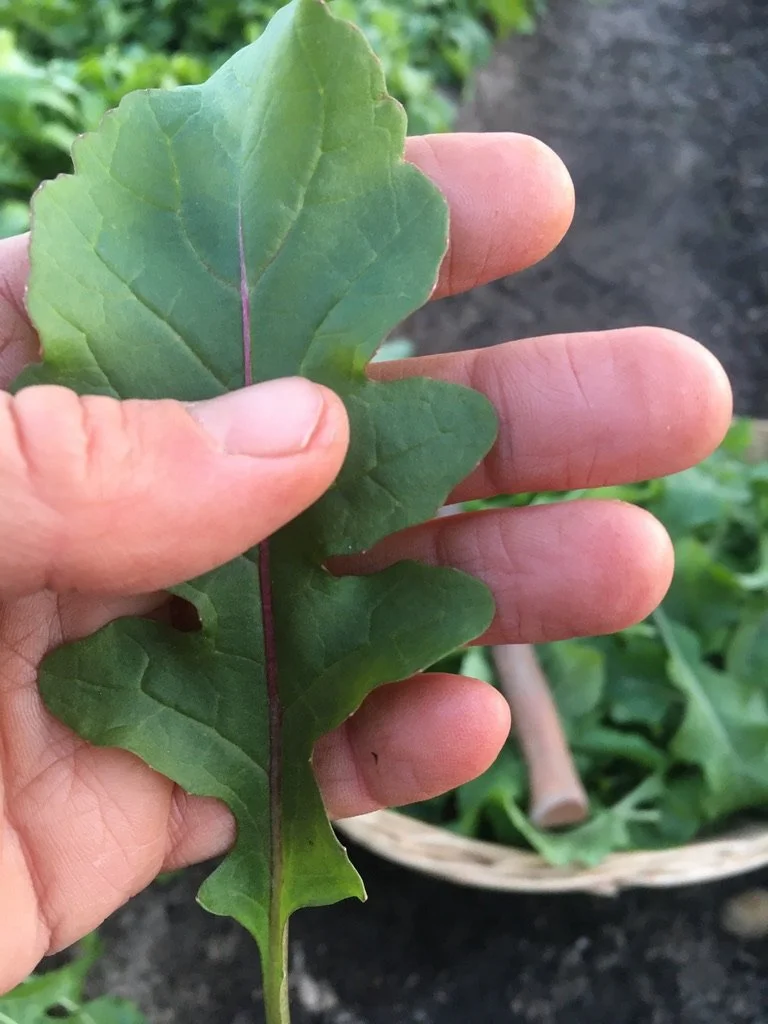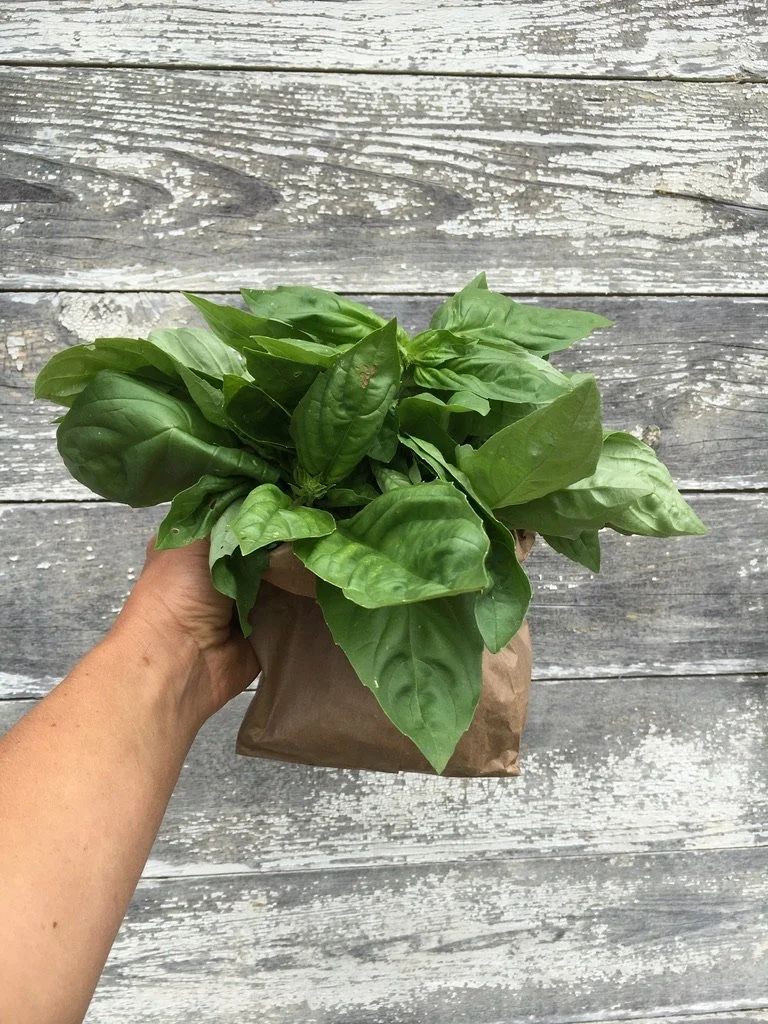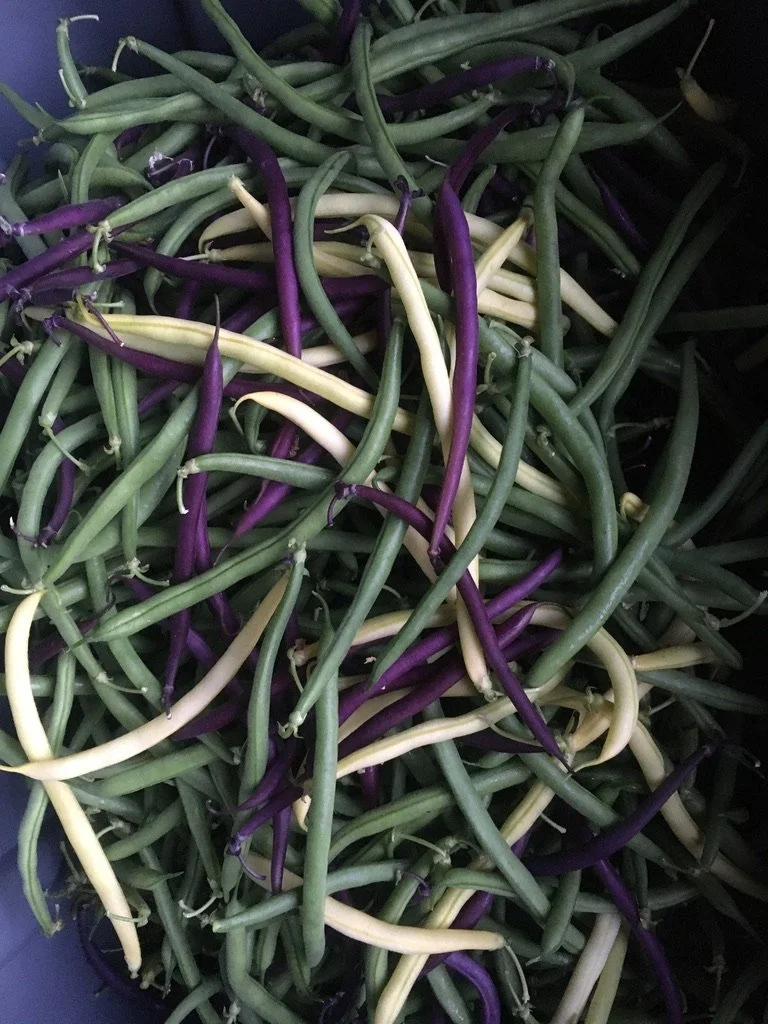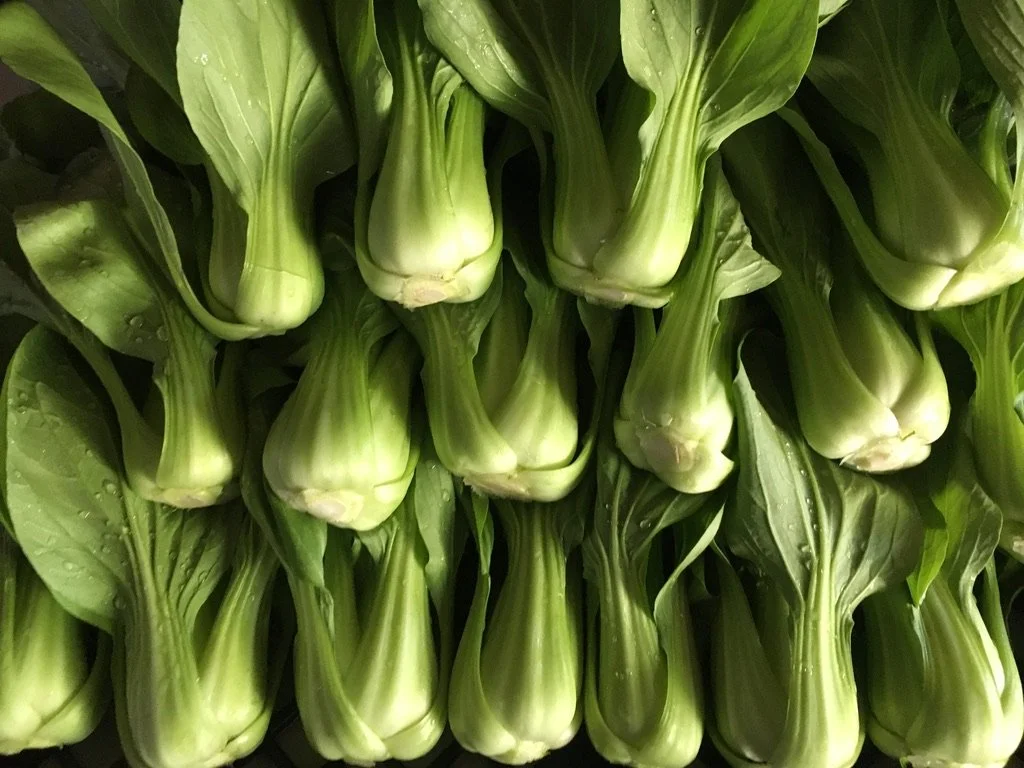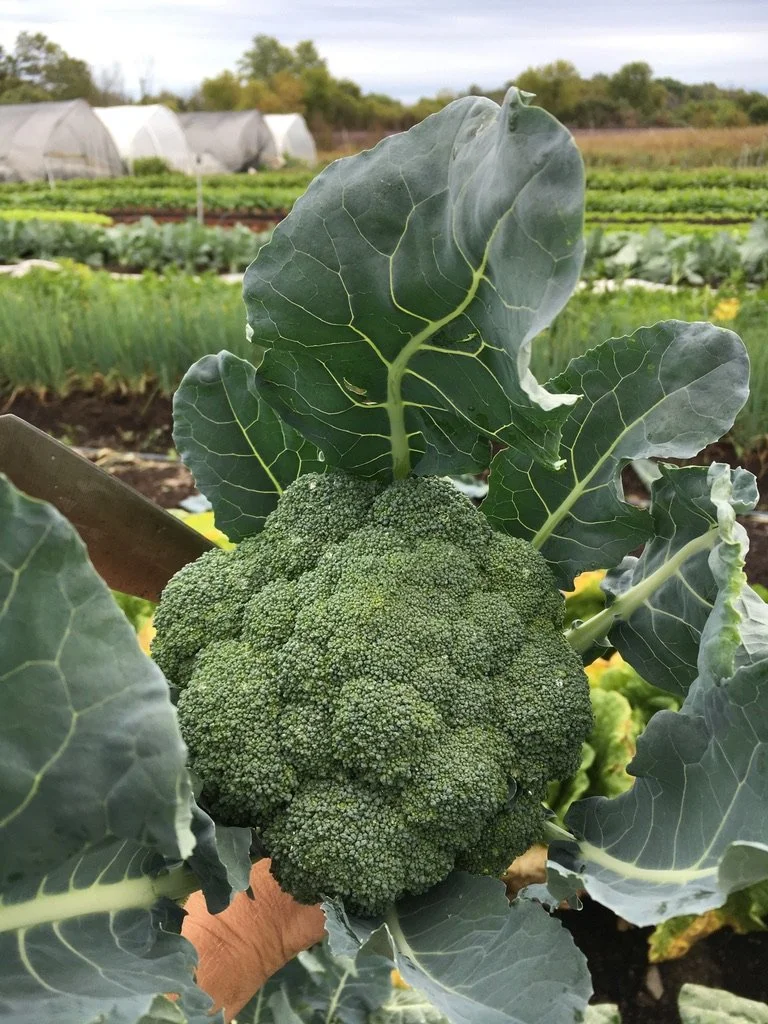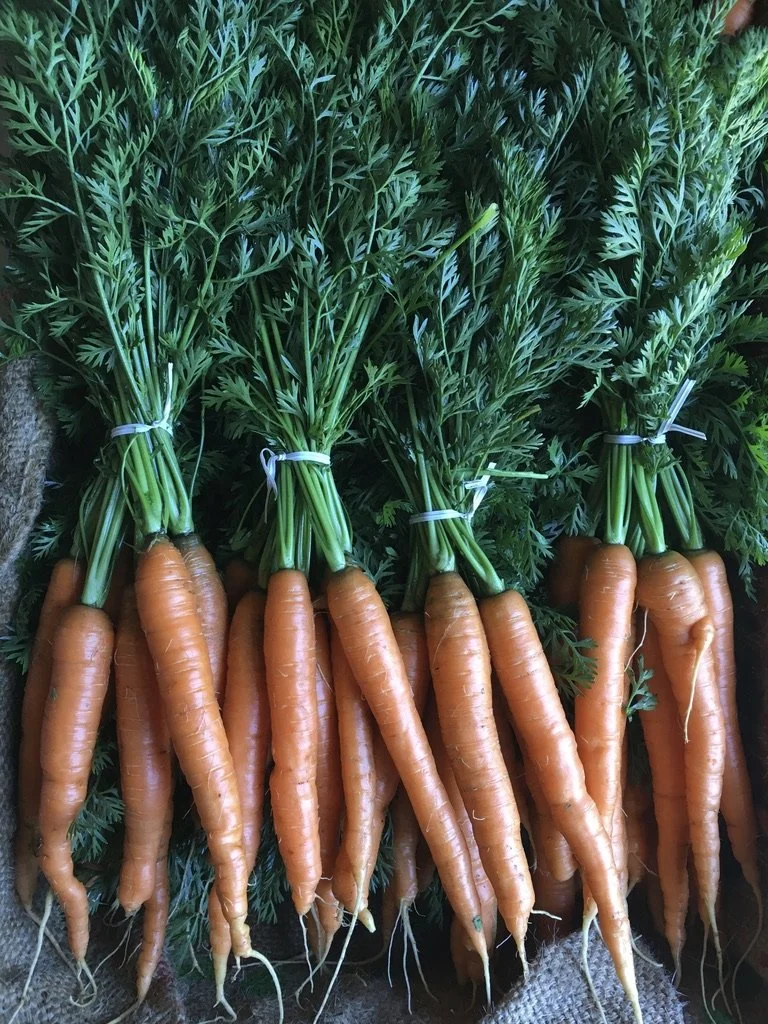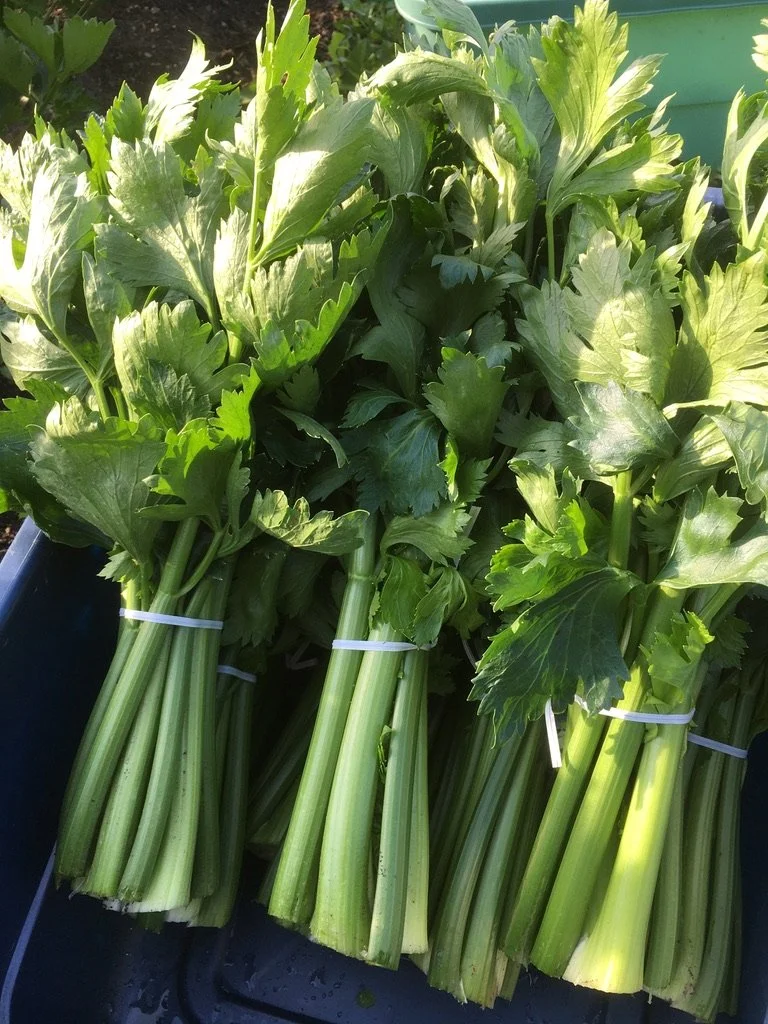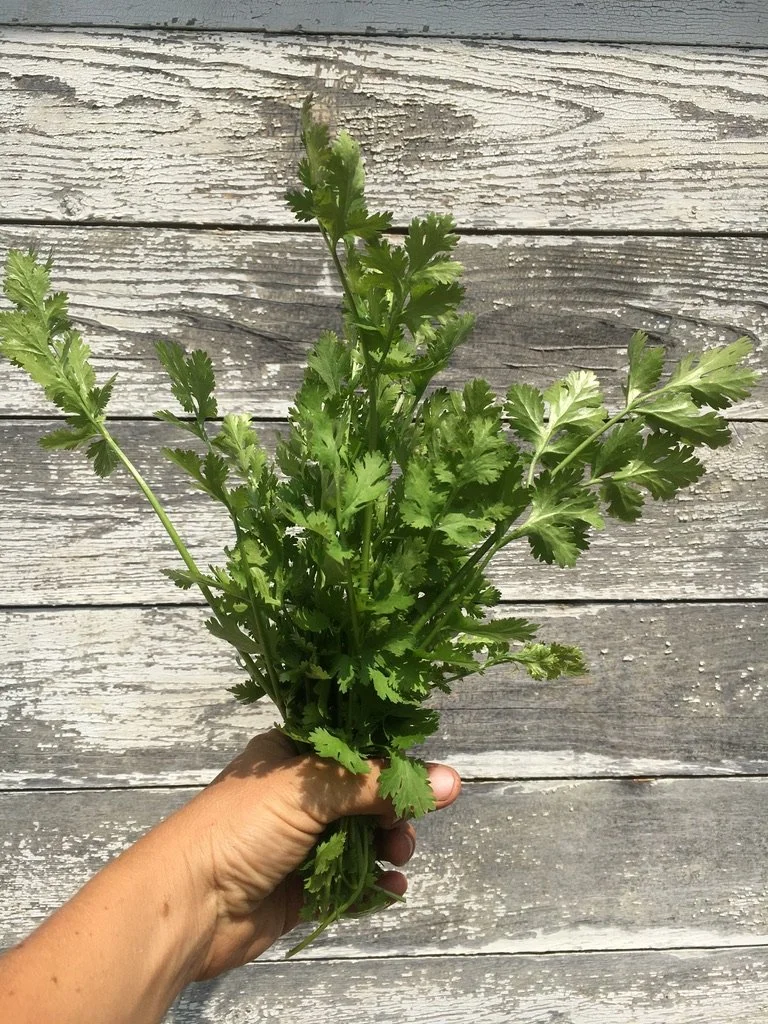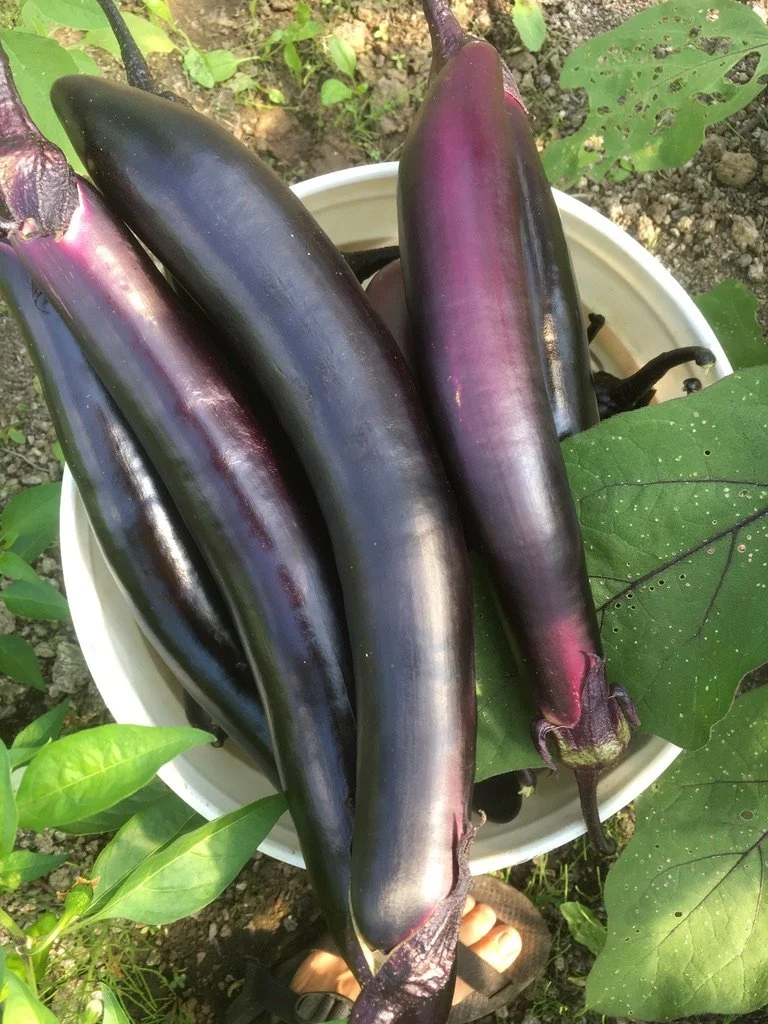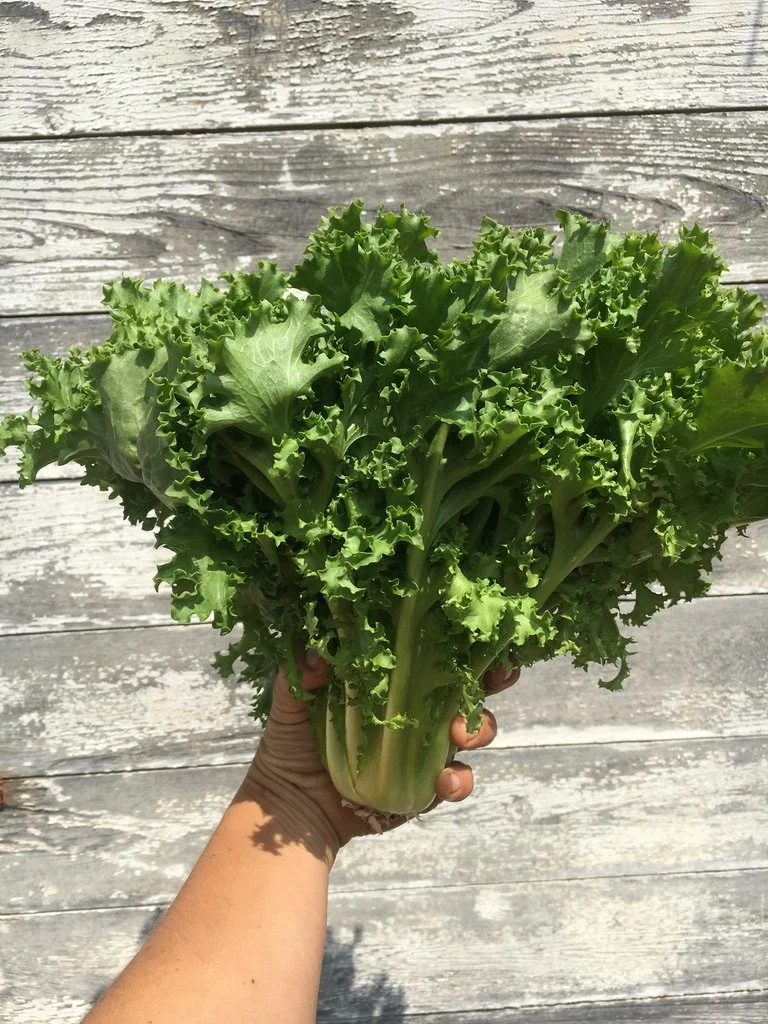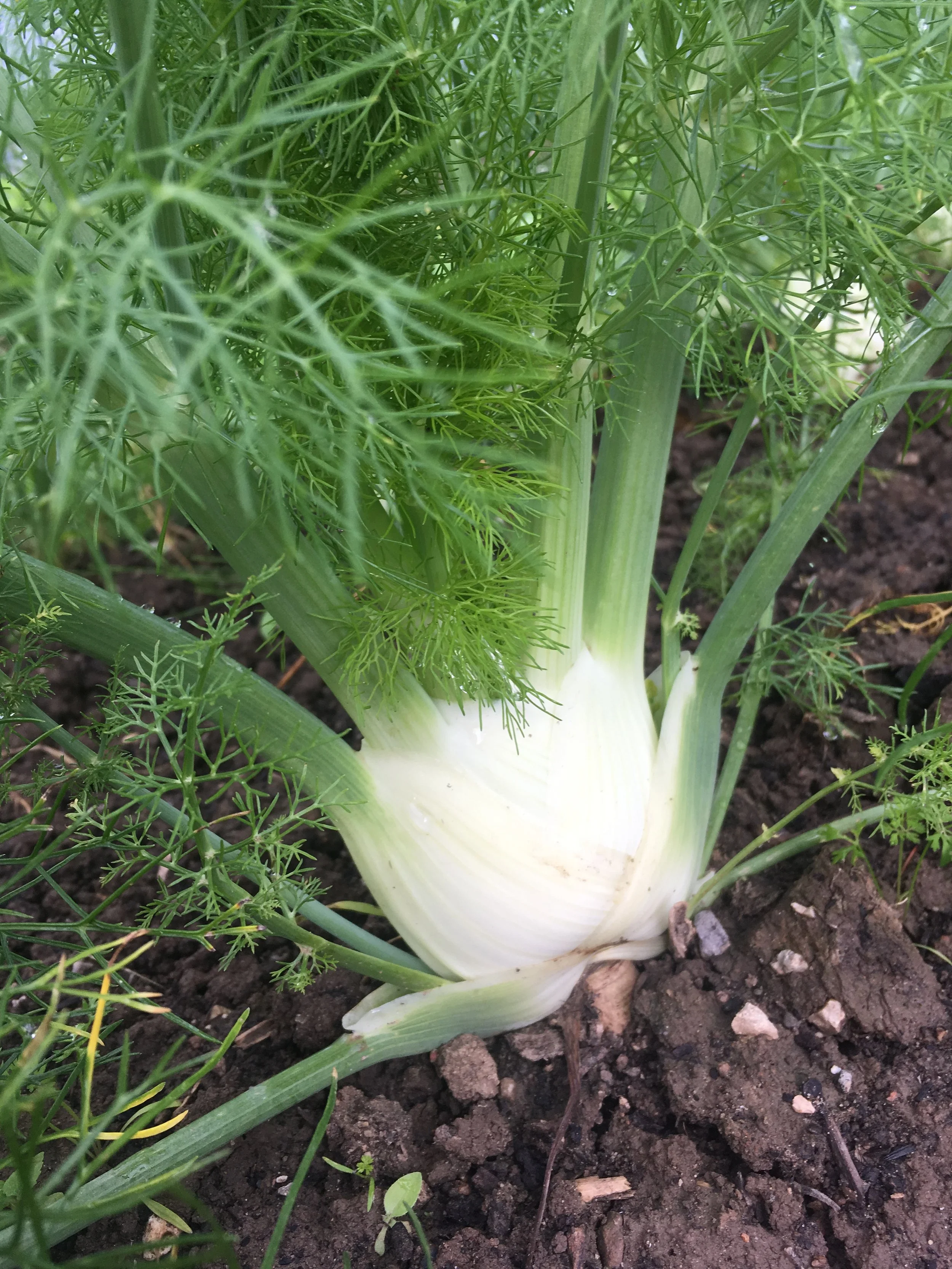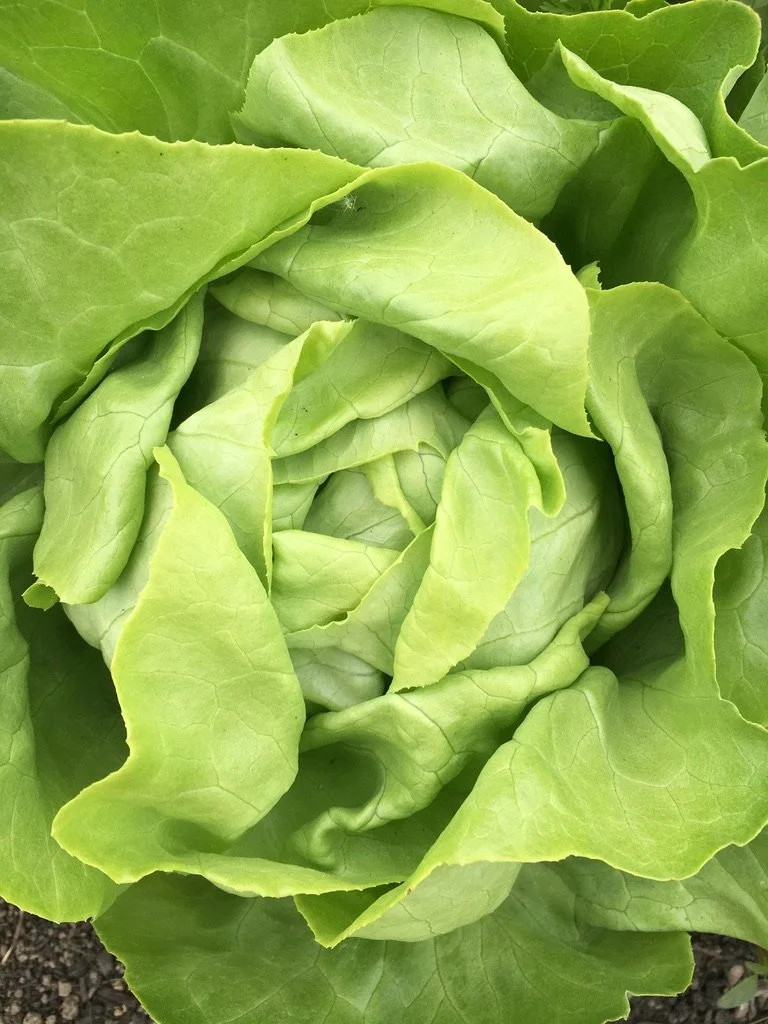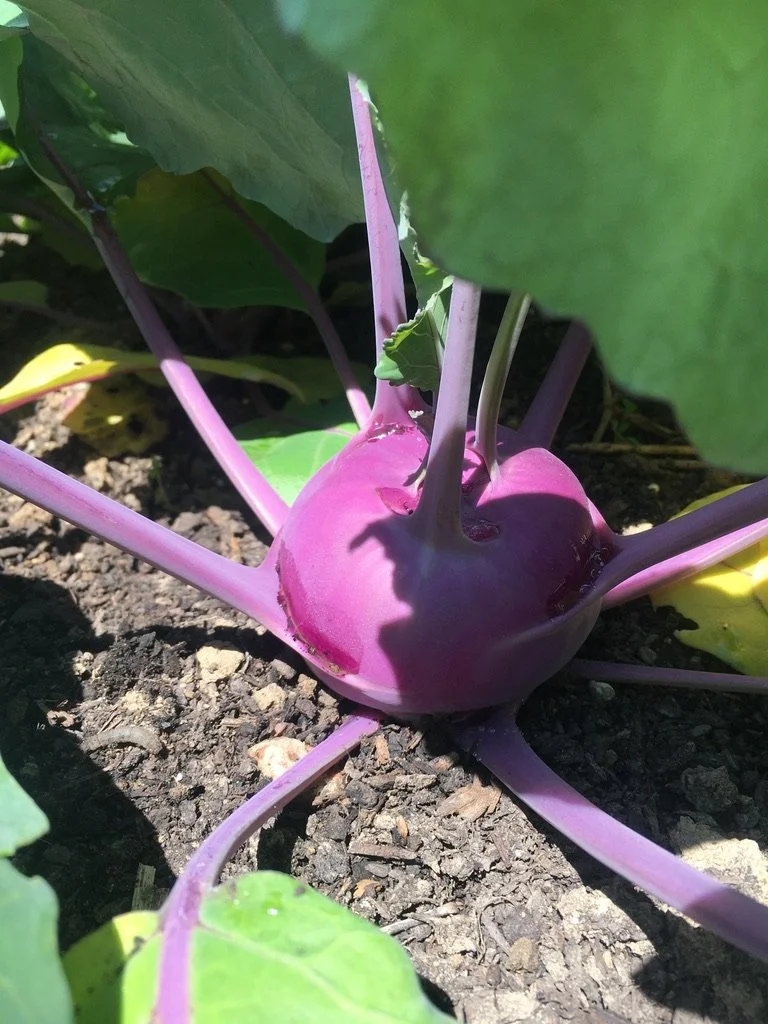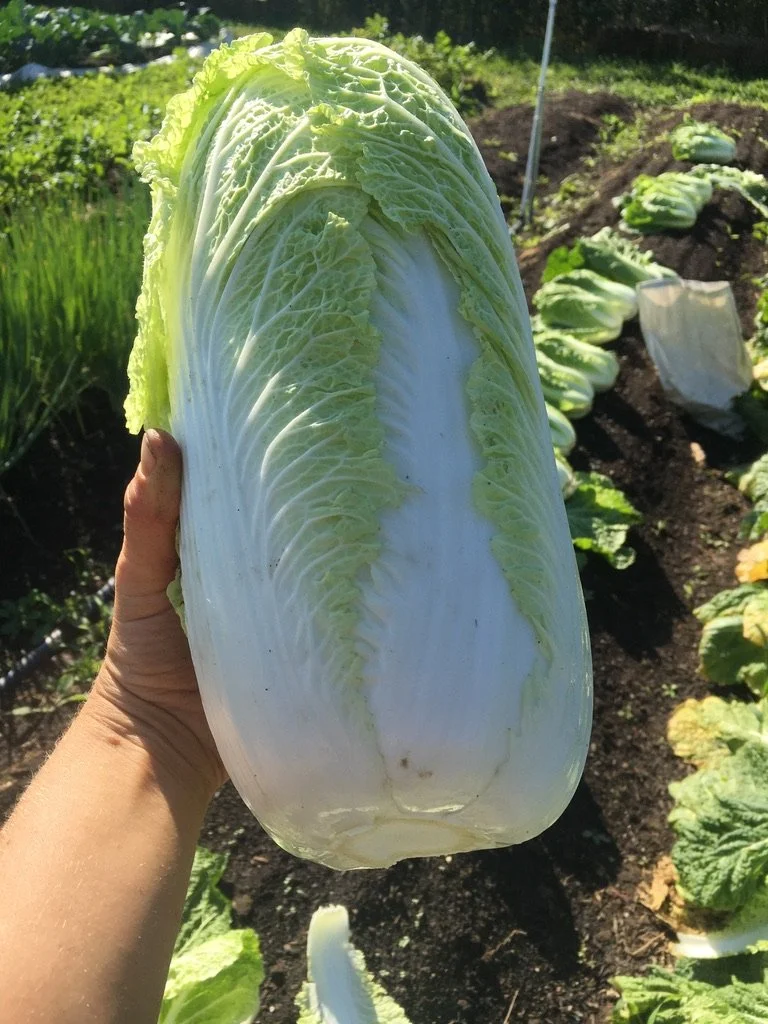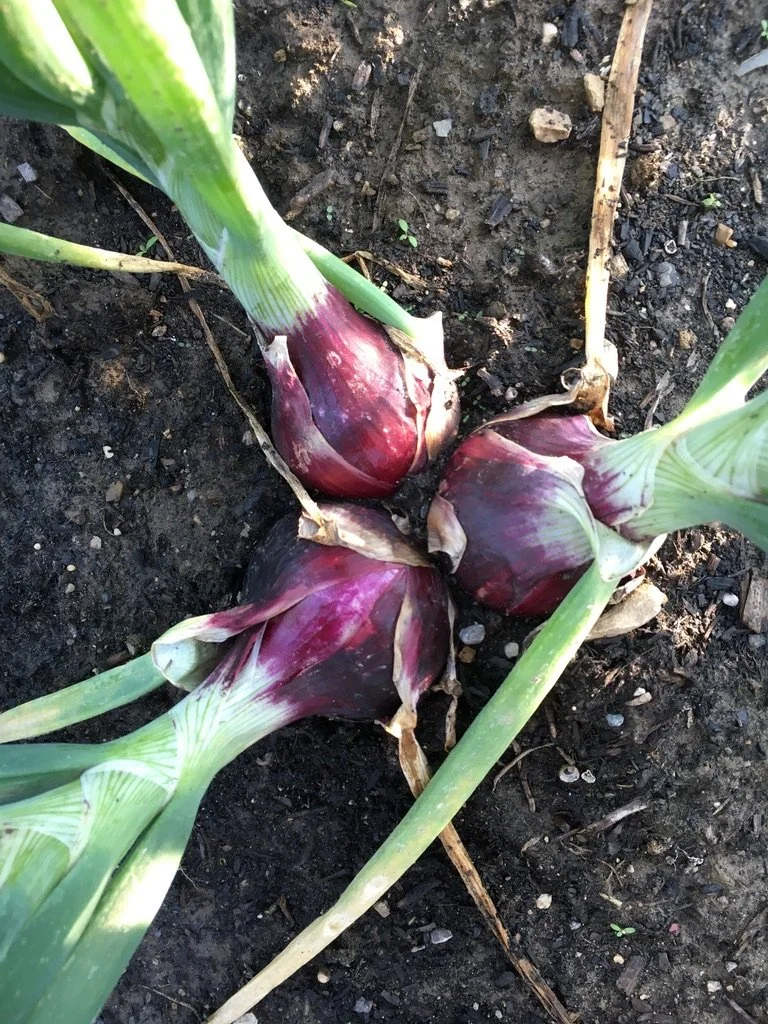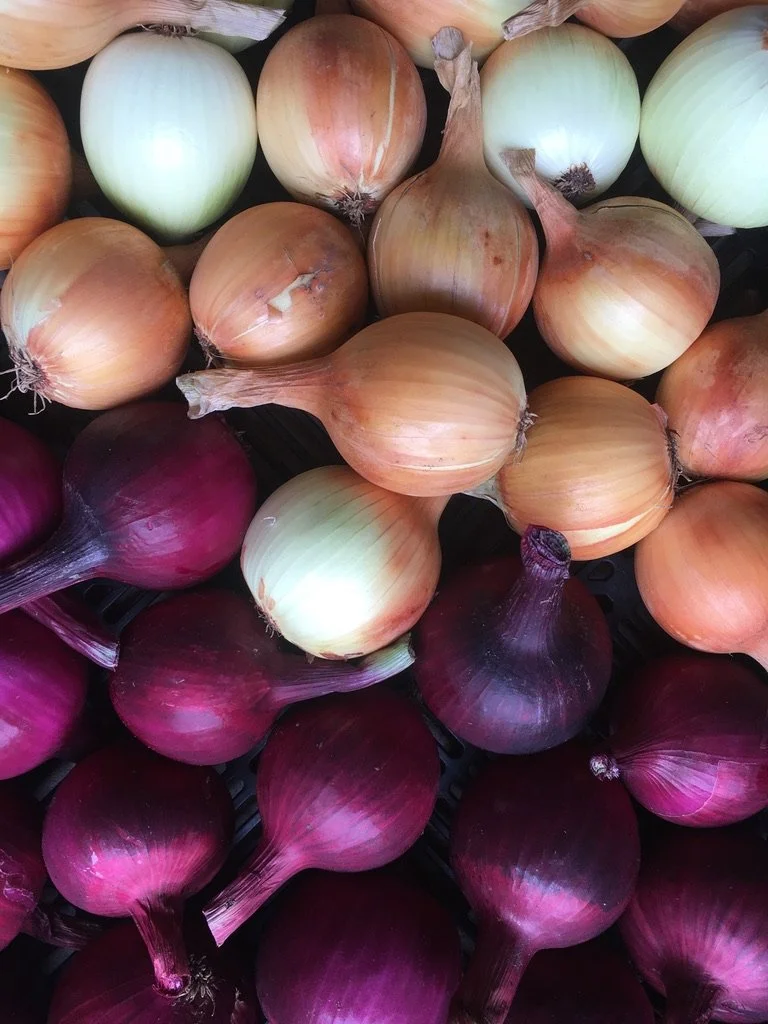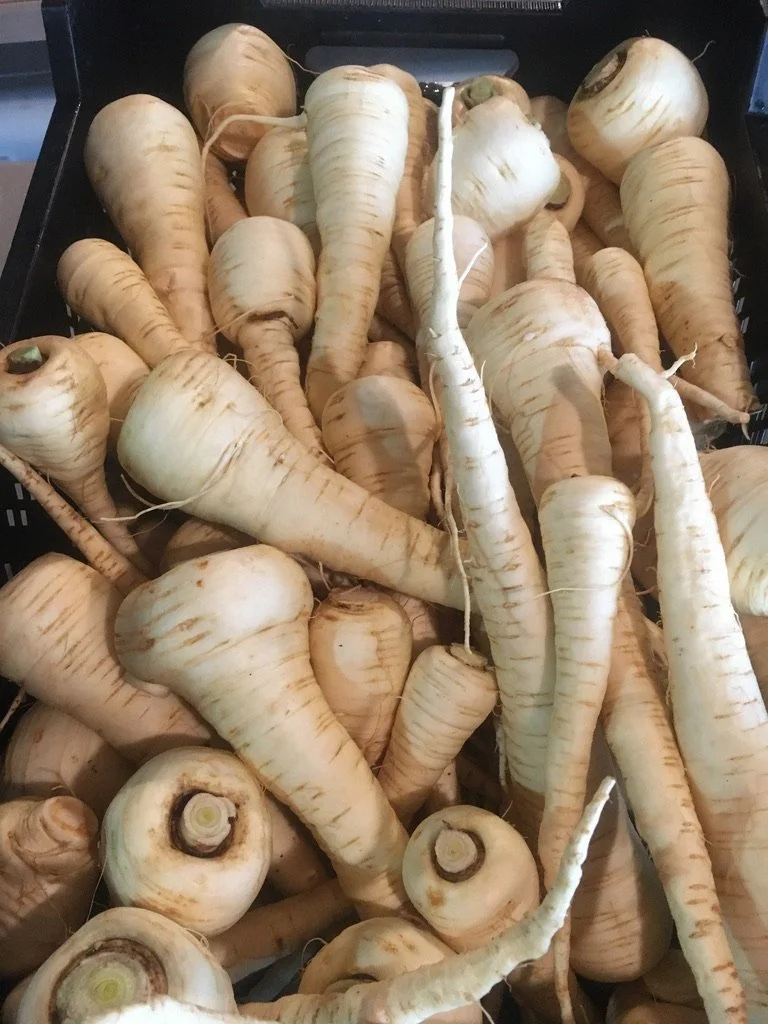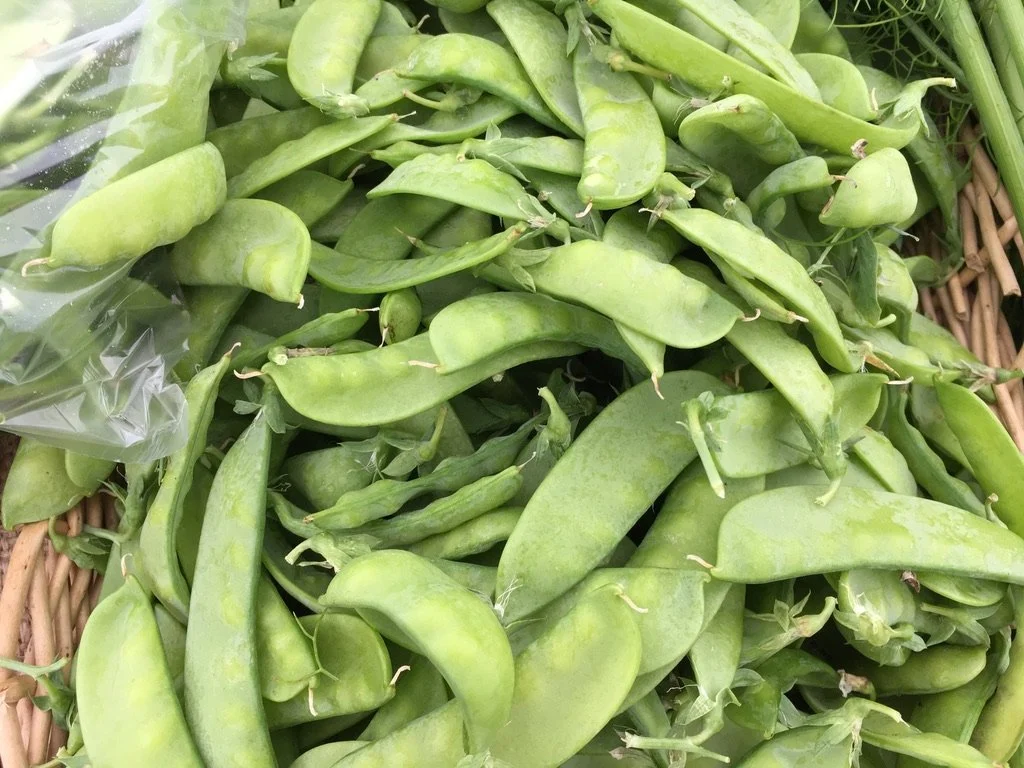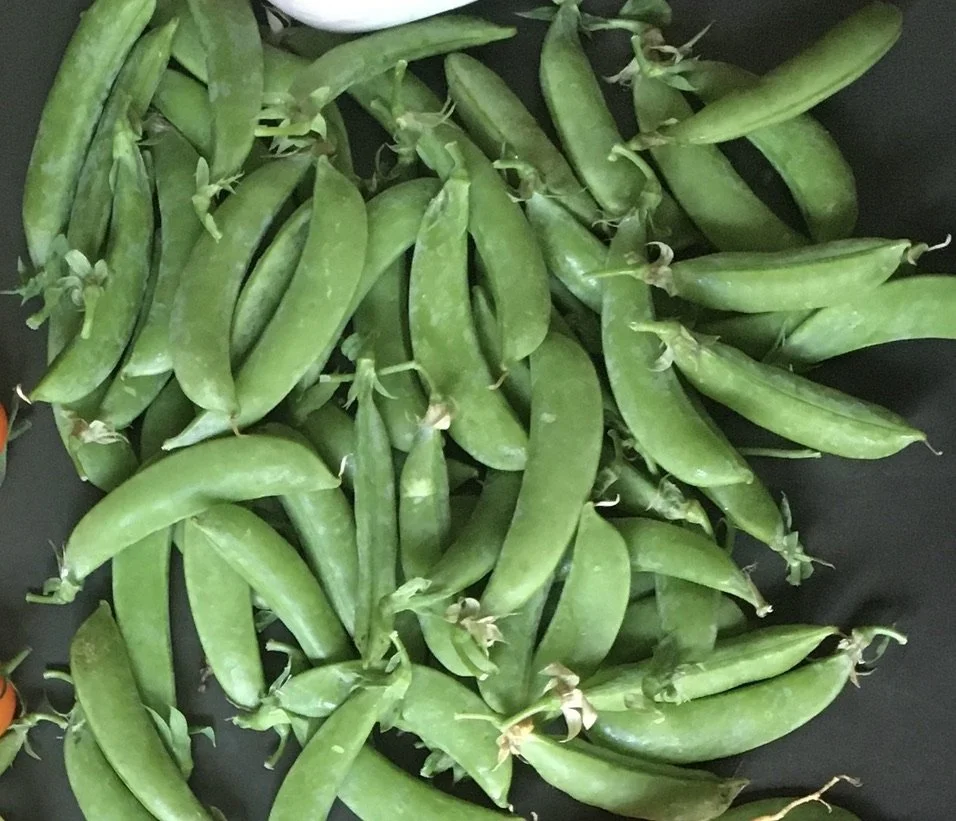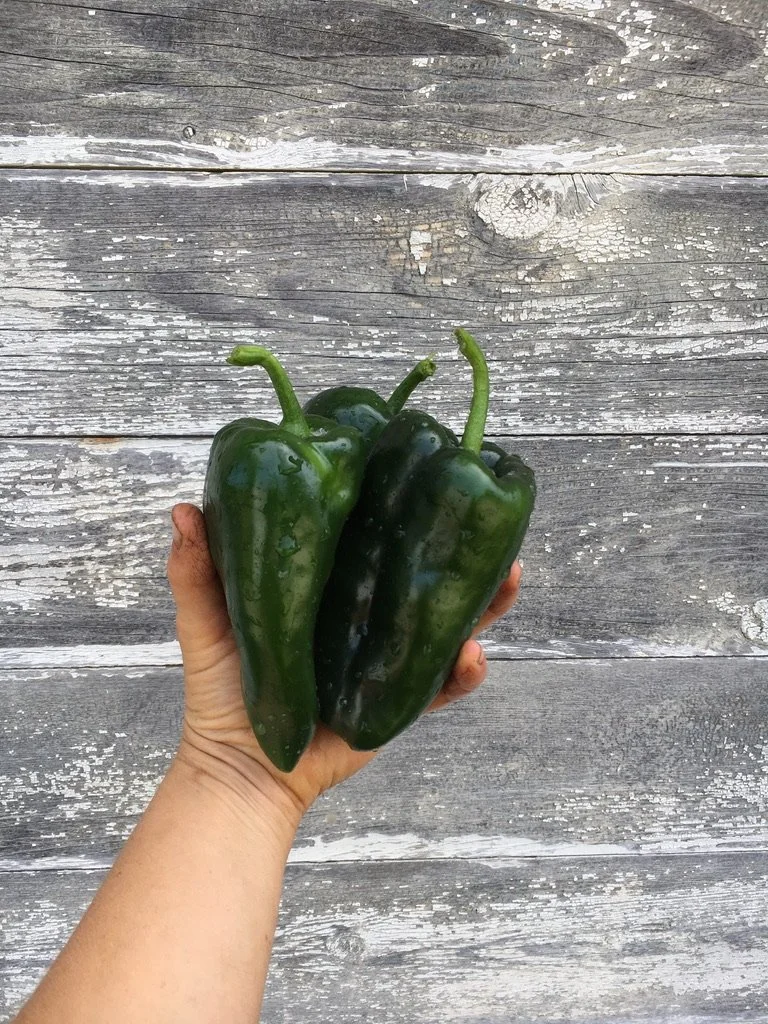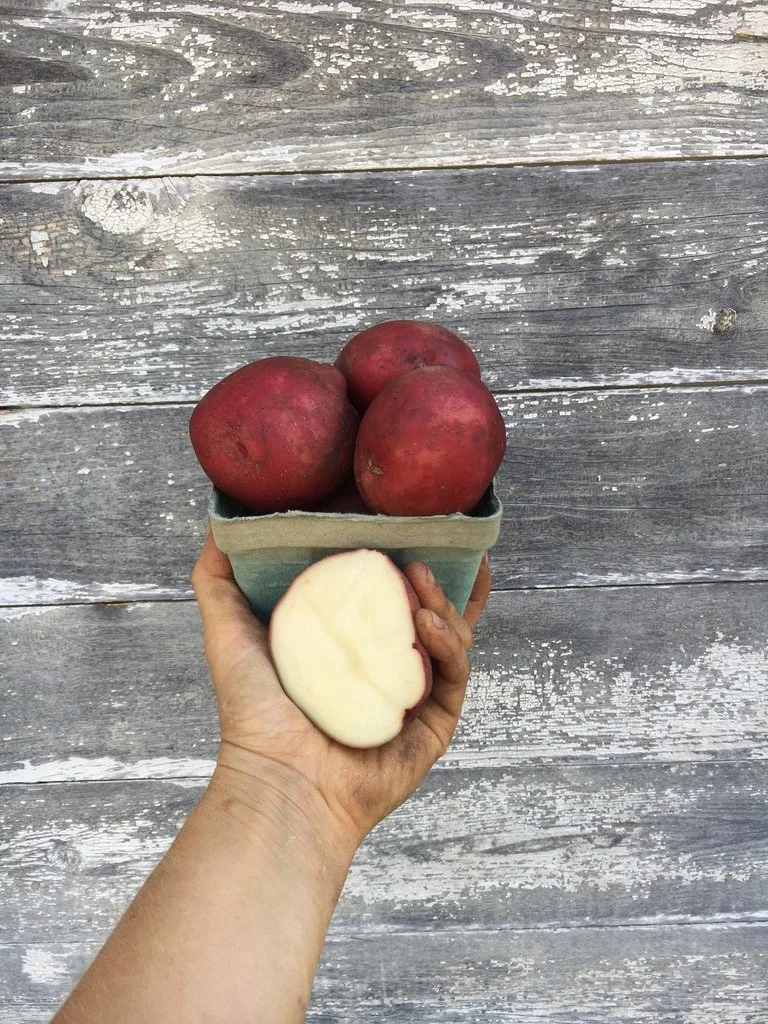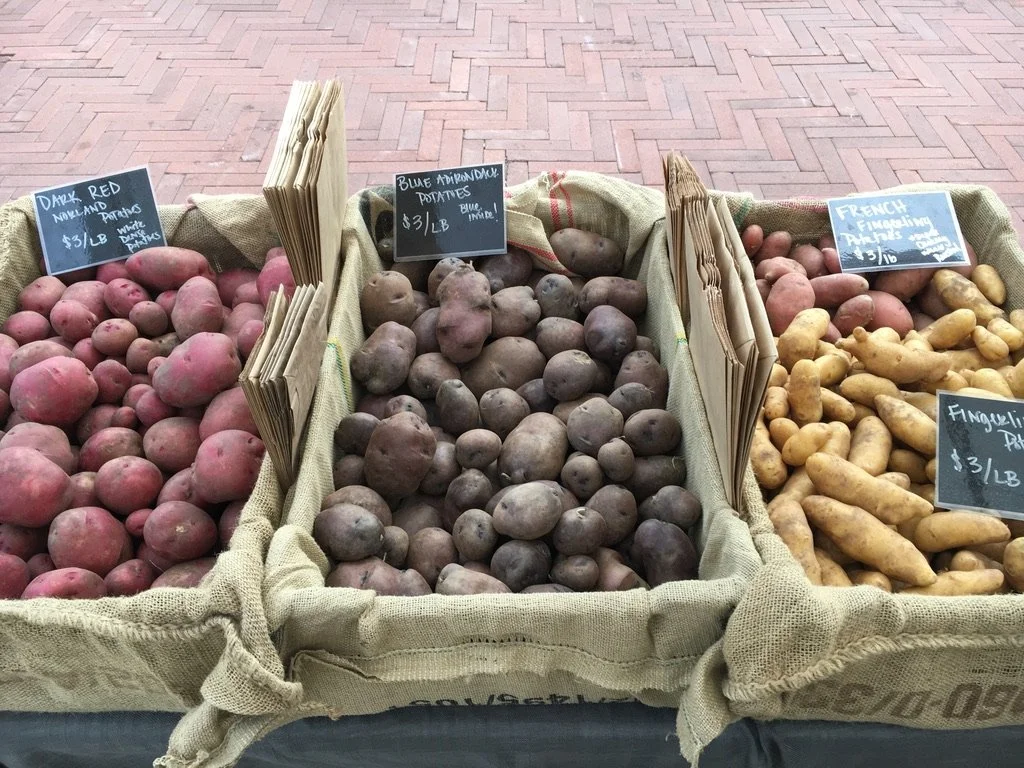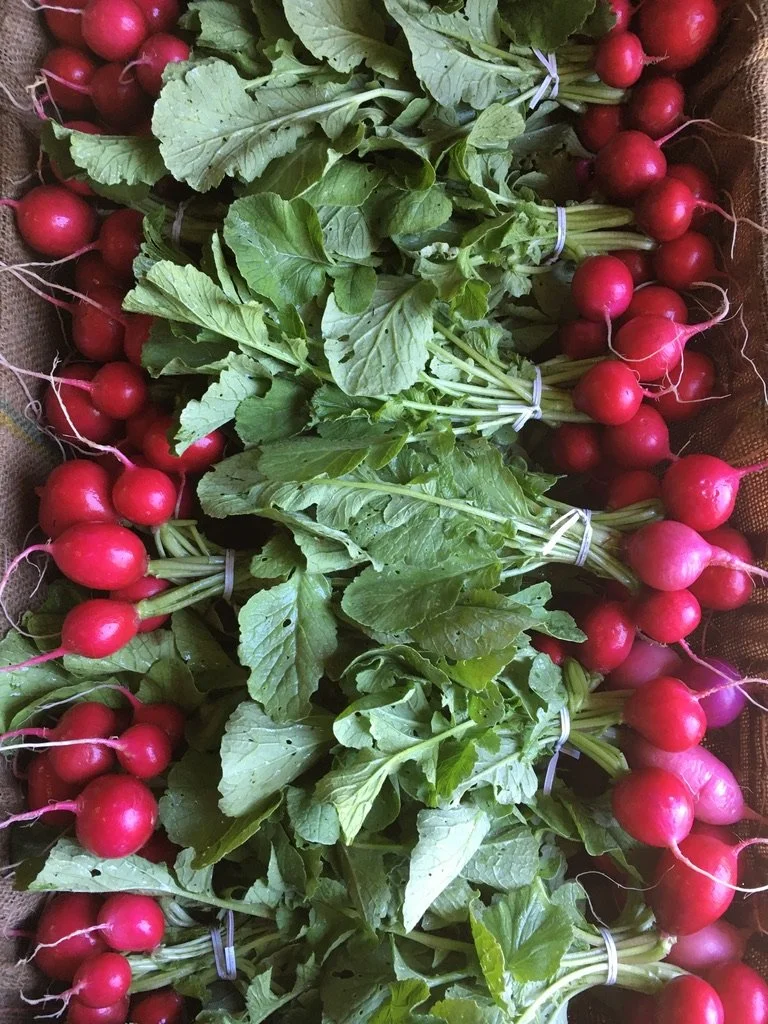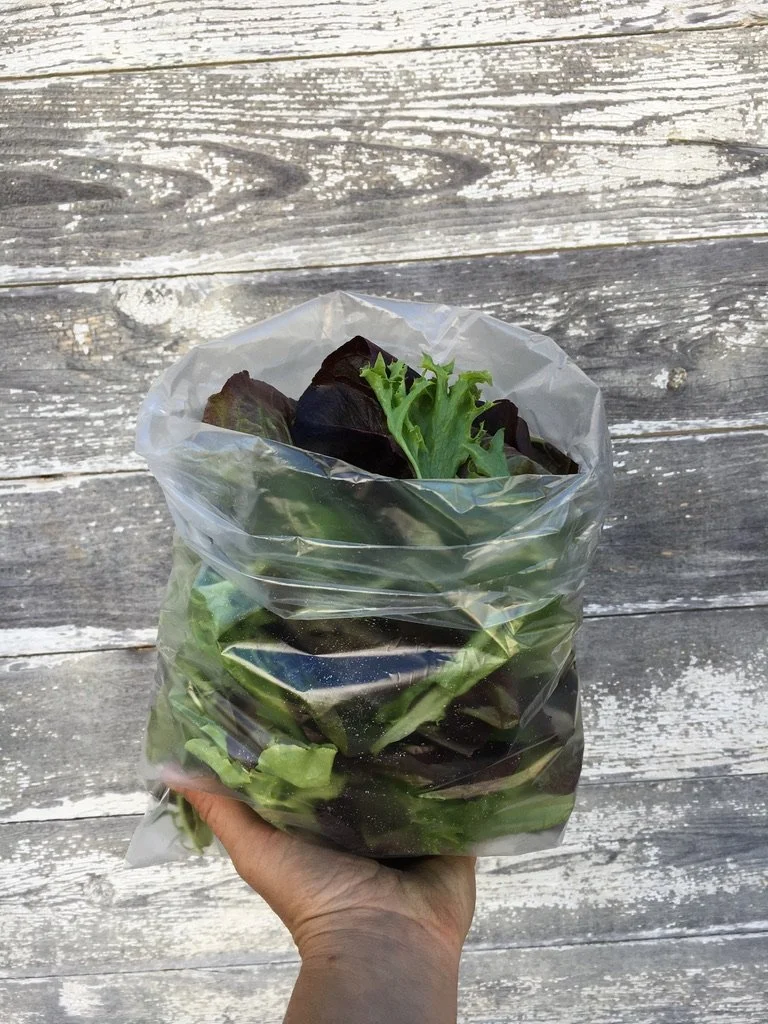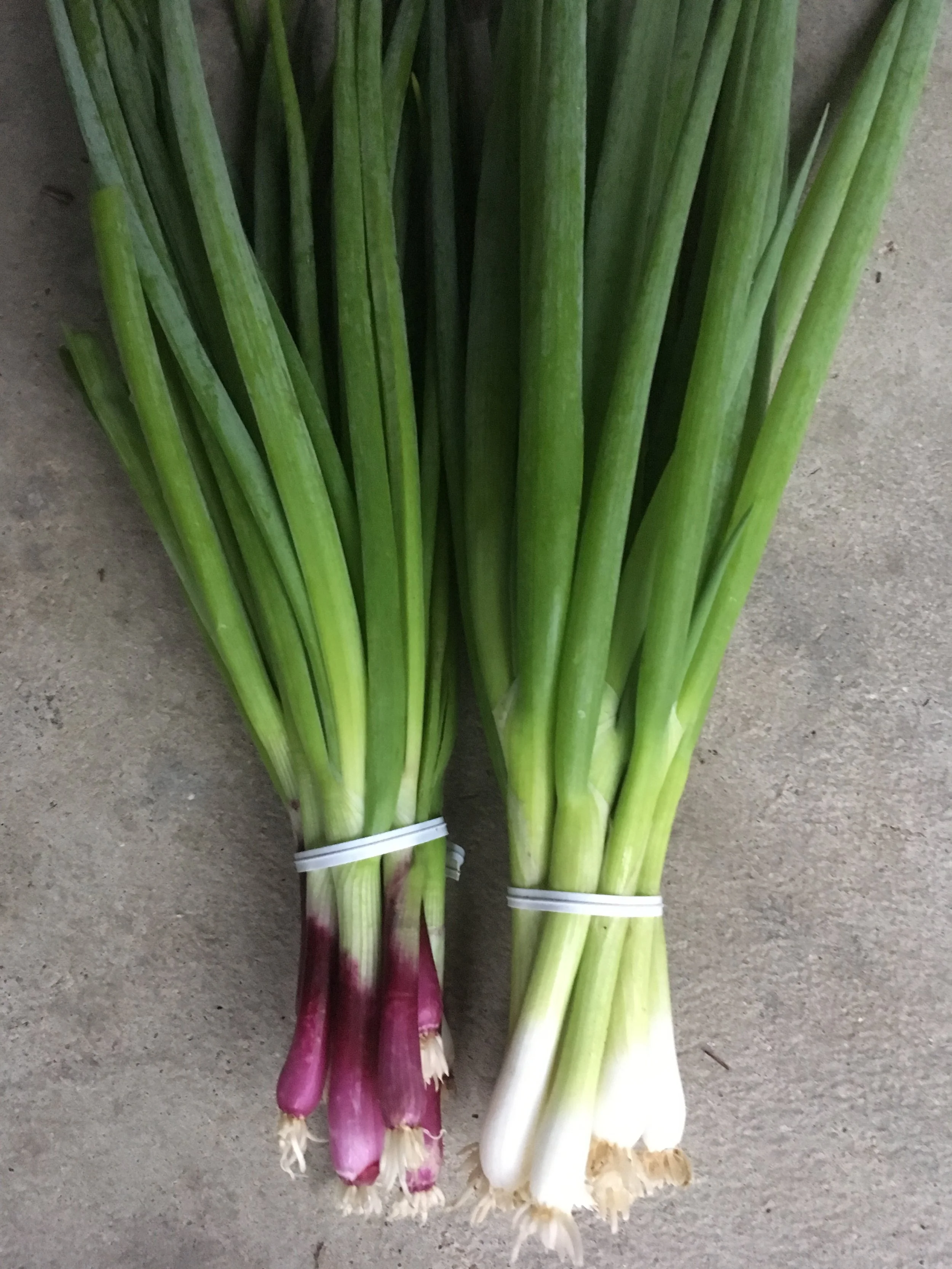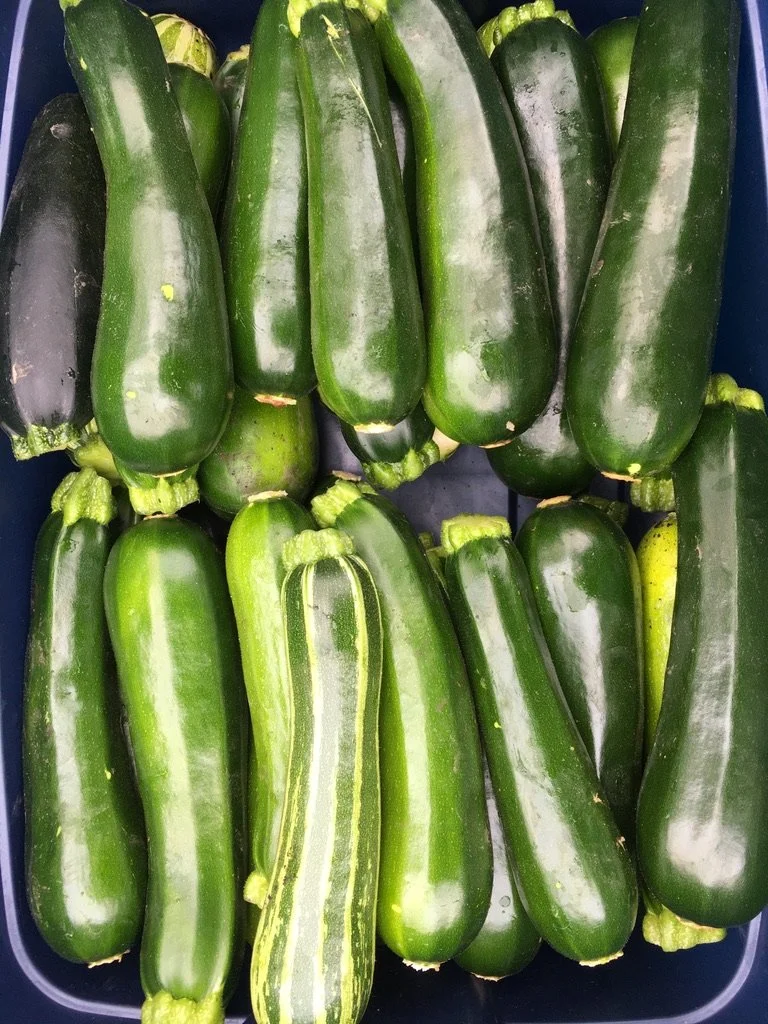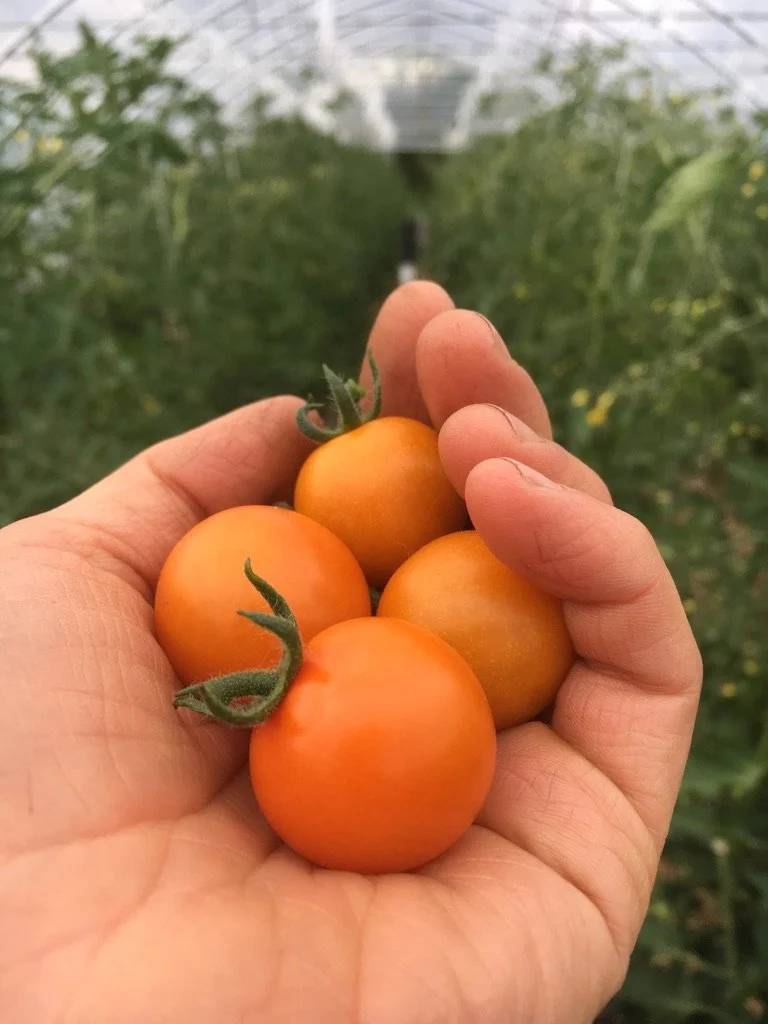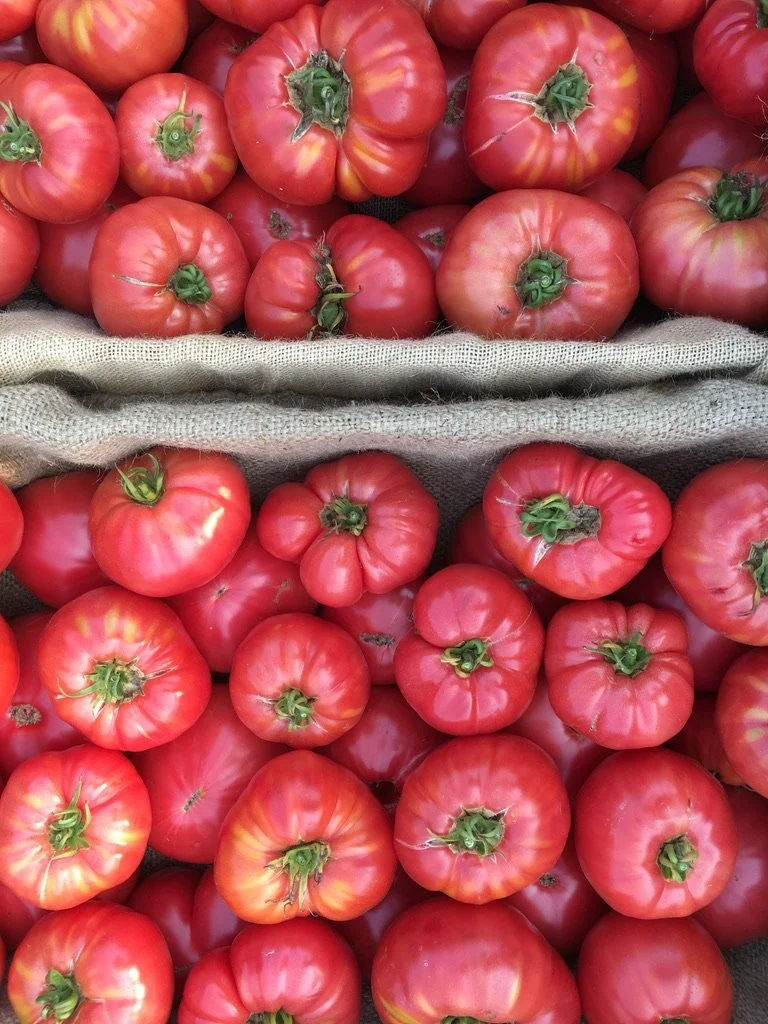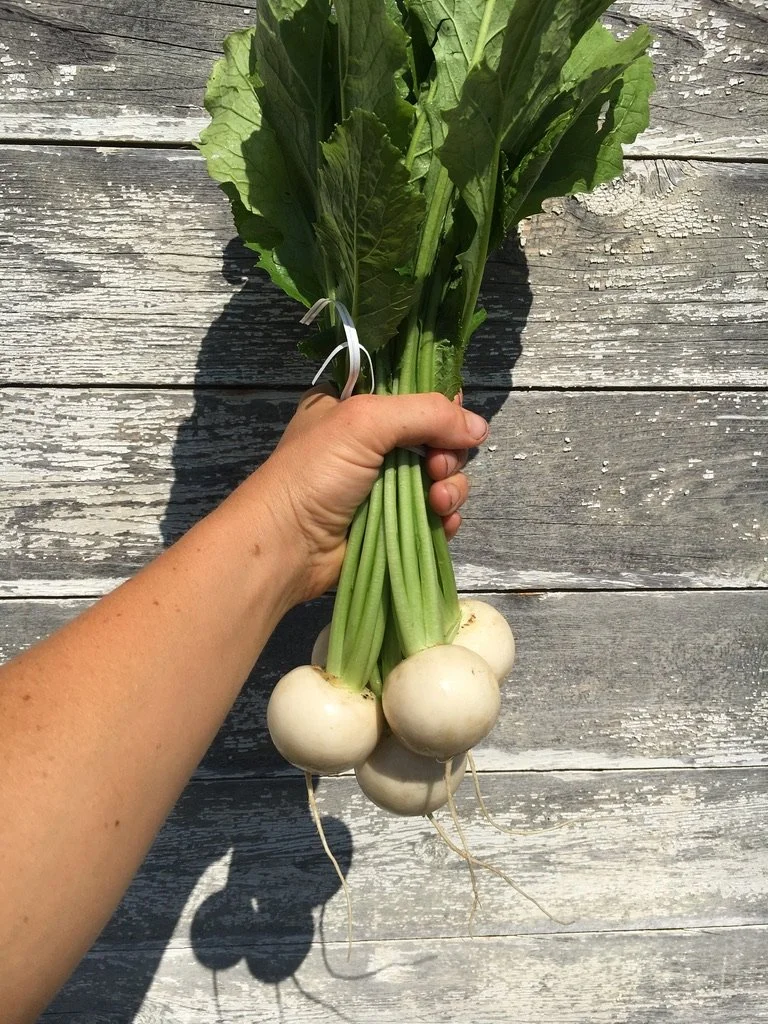Storage Tips
arugula
Store in a closed container or in a plastic bag in the fridge. Keeping the greens closed off from the dry air in the fridge can make them last for longer than a week. To extend the harvest, make arugula pesto and freeze in glass jars.
basil
Basil stores best at 50-60 F. Depending on the season and variety of your basil, it can be sensitive to the cold fridge and turn black. We usually line a container with a damp tea towel or cloth napkin and put the basil inside with an airtight lid for storage outside of the fridge. To extend the harvest, make pesto and freeze in glass jars.
beans
Store in a closed container or plastic bag in fridge. They will keep for 1-2 weeks. To extend the harvest, trim the stem and freeze.
beets
Remove greens. The root is the energy source of the whole plant, and even though we like to include the greens attached, the greens draw nutrients from the roots as they store. Keep roots in a closed container or plastic bag in the fridge. Roots like a humid environment, and will keep for 4-6 months if stored correctly.
bok Choy
Store in a closed container or in a plastic bag in the fridge. Keeping the greens closed off from the dry air in the fridge can make them last for longer than a week. To extend the harvest, cut and freeze.
broccoli & broccolini
Store in a closed container or in a plastic bag in the fridge. The florets can last up to two weeks. To extend the harvest, cut and freeze.
cabbage
Store in a closed container or in a plastic bag in the fridge. Cabbage can last for months if kept in an airtight container. If the outer leaves begin to yellow or get mushy, remove them to reveal fresh leaves.
carrots
Remove greens. The root is the energy source of the whole plant, and even though we like to include the greens attached, the greens draw nutrients from the roots as they store. Keep roots in a closed container or plastic bag in the fridge. Roots like a humid environment, and will keep for 4-6 months if stored correctly.
celery
If you haven’t tried celery grown on a small scale, you’re in for some flavor. Our celery tends to have a much stronger flavor and less water content than conventional celery. Truthfully, it tends to be more fibrous, too, so we like to cut it pretty thin (unless I’m using it as a shovel for peanut butter!) Store in a closed container or in a plastic bag in the fridge. The stalks will stay crisp for 2-4 weeks. If they begin to seem wilty, trim the ends and put them in a jar of water in the fridge. To extend the harvest, cut and freeze.
cilantro
Store in a closed container or in a plastic bag in the fridge. Alternatively, fill a jar with water, take off the twist tie, and put the stems in the jar in the fridge. Will last 1-2 weeks. To extend the harvest, either chop and freeze, or make chimichurri and freeze in glass jars.
cucumber
Even though most refrigerators are a few degrees colder than the ideal temperature for cukes, we find that they stay crisper inside the fridge inside a closed container or plastic bag, rather than out on the counter. To extend the harvest, pickle with vinegar or ferment with a salt water brine.
eggplant (japanese)
Even though most refrigerators are a few degrees colder than the ideal temperature for eggplants, we find that they stay crisper inside the fridge inside a closed container or plastic bag, rather than out on the counter. To extend the harvest, cut and freeze.
Endive
Store in a closed container or in a plastic bag in the fridge. Keeping the greens closed off from the dry air in the fridge can make them last for longer than a week.
Fennel
Store in a closed container or in a plastic bag in the fridge. The fronds (the frilly parts) will be the first to start yellowing. The bulb can last up to a month if the stalks are trimmed off. To extend the harvest, cut and freeze, or pickle with sweet peppers and onions.
garlic
Store outside of fridge, away from direct sunlight with good ventilation. Hardneck varieties should be eaten first, as their shelf life is shorter. Softneck varieties are a little more tedious to work with in the kitchen, but they store longer, which is why we grow both.
head lettuce - butterhead
Store in a closed container or in a plastic bag in the fridge. Keeping the greens closed off from the dry air in the fridge can make them last for longer than a week.
head lettuce - romaine
Store in a closed container or in a plastic bag in the fridge. Keeping the greens closed off from the dry air in the fridge can make them last for longer than a week.
kale
Store in a closed container or in a plastic bag in the fridge. Keeping the greens closed off from the dry air in the fridge can make them last for longer than a week. To extend the harvest, chop and freeze.
kohlrabi
Store in a closed container or in a plastic bag in the fridge. Kohlrabi can last for months if kept in an airtight container. After about 2 months, the skin will likely yellow, but peeling the kohlrabi will reveal the crisp inner flesh that is perfectly healthy to eat raw and cooked.
leeks
Store in a closed container or in a plastic bag in the fridge. Leeks should last for 2-3 weeks. Most people don’t use the greens because they are tougher than the white part. Cutting them in thin slices is the best way to prepare them. Pro-tip: if you cut them lengthwise first, they won’t roll off your cutting board as you cut them into smaller pieces.
napa cabbage
Store in a closed container or in a plastic bag in the fridge. Napa cabbage can last for weeks if kept in an airtight container. If the outer leaves begin to yellow or get mushy, remove them to reveal fresh leaves. Napa does not last as long as green cabbages, but our favorite way to extend the harvest is to ferment it!
onions - fresh
Store in the fridge, especially if they have the greens. Fresh onions will last for about a month.
onions - storage
Store outside of fridge, away from direct sunlight with good ventilation. Storage onions can last for 4-6 months. Yellow onions tend to have a higher water content, making them sweeter tasting and great for cooking, but have a shorter shelf life because of this. Red onions tend to be more pungent and less watery, making them great for eating raw or cooking, and have a longer shelf life than yellow onions. Store onions away from potatoes and apples.
parsnips
Keep roots in a closed container or plastic bag in the fridge. Roots like a humid environment, and will keep for 4-6 months if stored correctly.
peas - snow
Store in a closed container or plastic bag in fridge. They will keep for 1-2 weeks. To extend the harvest, trim the stem and freeze.
peas - sugar snap
Store in a closed container or plastic bag in fridge. They will keep for 1-2 weeks. To extend the harvest, trim the stem and freeze.
peppers - bell
Even though most refrigerators are a few degrees colder than the ideal temperature for peppers, we find that these veggies stay crisper inside the fridge inside a closed container or plastic bag, rather than out on the counter. To extend the harvest cut and freeze or pickle with onions.
peppers - poblano
Even though most refrigerators are a few degrees colder than the ideal temperature for peppers, we find that these veggies stay crisper inside the fridge inside a closed container or plastic bag, rather than out on the counter. To extend the harvest, cut and freeze, or roast on an open flame, remove blackened skin, and add to salsa.
peppers - shishito
Even though most refrigerators are a few degrees colder than the ideal temperature for peppers, we find that these veggies stay crisper inside the fridge inside a closed container or plastic bag, rather than out on the counter. To extend the harvest, freeze whole.
peppers - sweet Italian
Even though most refrigerators are a few degrees colder than the ideal temperature for peppers, we find that these veggies stay crisper inside the fridge inside a closed container or plastic bag, rather than out on the counter. To extend the harvest cut and freeze or pickle with onions.
Potatoes - fresh
Store in a closed container or in a plastic bag in the fridge. Fresh potatoes are freshly harvested, making their skin very fragile and flesh very tender. They cook quickly are are intended for eating right away. Fresh potatoes will be at their best for about a month.
potatoes - storage
Store outside of fridge, in a cool, dark place, away from onions. Storage potatoes have been cured, toughening their skin to hold in the moisture of the fruit. Potatoes produce ethylene gas, a natural hormone that is released by many fruits and vegetables. This causes other vegetables to prematurely ripen - mostly onions and apples, so keep them away from your onions and garlic. Potatoes can last 3-5 months stored this way.
radishes
Remove greens. The root is the energy source of the whole plant, and even though we like to include the greens attached, the greens draw nutrients from the roots as they store. Keep roots in a closed container or plastic bag in the fridge. Radishes like a humid environment and can last up to 2 months stored this way.
salad mix
Store in a closed container or in a plastic bag in the fridge. Keeping the greens closed off from the dry air in the fridge can make them last for longer than a week.
scallions
Store in a closed container or in a plastic bag in the fridge. They should last about 2 weeks. To extend the harvest, freeze whole or chopped in an airtight plastic bag.
spinach
Store in a closed container or in a plastic bag in the fridge. Keeping the greens closed off from the dry air in the fridge can make them last for longer than a week. To extend the harvest, freeze.
summer squash
Even though most refrigerators are a few degrees colder than the ideal temperature for these crops, we find that these veggies stay crisper inside the fridge inside a closed container or plastic bag, rather than out on the counter. To extend the harvest, cut and freeze.
tomatoes - cherry
Tomatoes taste best when they are stored out of the fridge. Depending on their ripeness, they will last about 1-2 weeks. To extend the harvest, freeze whole or can.
tomatoes - heirloom & slicing
Tomatoes taste best when they are stored out of the fridge. Depending on their ripeness, they will last about 1-2 weeks. To extend the harvest, freeze whole or can.
turnips - japanese salad
Remove greens. The root is the energy source of the whole plant, and even though we like to include the greens attached, the greens draw nutrients from the roots as they store. The greens are delicious and nourishing! Add them to salads or stir fries. Keep roots in a closed container or plastic bag in the fridge. Salad turnips are grown to be eaten fresh, but they can last over a month stored this way.
